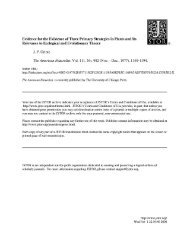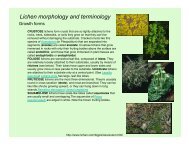Arctic Ecosystems in Russia - Alaska Geobotany Center
Arctic Ecosystems in Russia - Alaska Geobotany Center
Arctic Ecosystems in Russia - Alaska Geobotany Center
Create successful ePaper yourself
Turn your PDF publications into a flip-book with our unique Google optimized e-Paper software.
ARCTIC ECOSYSTEMS IN RUSSIA 417<br />
Fig. 16.46. Regular structural type of the vegetation cover <strong>in</strong> a<br />
polygonal mire at Tareya, Taymyr. 1, Saturated center of<br />
polygon with homogeneous plant cover; 2, rim with irregular<br />
mosaic structure; 3, saturated trough with homogeneous cover.<br />
Sample plot 60 x 60 m.<br />
series follow<strong>in</strong>g certa<strong>in</strong> environmental factors,<br />
most often snow depth.<br />
The special feature of the structure of vegetation<br />
cover <strong>in</strong> the tundra zone is its heterogeneity along<br />
with the relatively small size of the phytocenoses<br />
which, <strong>in</strong> turn, ma<strong>in</strong>ly have a mosaic pattern.<br />
Because of permafrost, all the usual forms of<br />
micro- and mesorelief and, consequently, the diversity<br />
of all types of <strong>in</strong>tra-landscape vegetation<br />
pattern, are represented <strong>in</strong> a relatively small area.<br />
This results <strong>in</strong> small m<strong>in</strong>imum areas of local flora<br />
and of the set of plant communities. All common<br />
types of communities are normally met repeatedly<br />
<strong>in</strong> an area of 5 x 5 km. In forest biomes, such an<br />
area can be occupied by a s<strong>in</strong>gle tract of forest or<br />
bog with a poor and monotonous community.<br />
DYNAMIC PROCESSES IN ARCTIC<br />
COMMUNITIES<br />
One of the ma<strong>in</strong> features of arctic communities<br />
is the uniqueness of the succession processes. In<br />
the temperate zones of the globe, the natural<br />
development of an ecosystem unaffected by anthropogenic<br />
factors leads to a climax.<br />
It is, however, problematic to apply the notion<br />
of climax to the "zonal" tundra communities. At<br />
the term<strong>in</strong>al stages of development of the liv<strong>in</strong>g<br />
plant cover <strong>in</strong> High <strong>Arctic</strong> latitudes, there is no<br />
state of stable equilibrium. Changes <strong>in</strong> the environment<br />
result<strong>in</strong>g from the development of the liv<strong>in</strong>g<br />
cover cont<strong>in</strong>ue, and the thicker this layer becomes,<br />
the worse it is for plant life. The live plant cover,<br />
as its thickness <strong>in</strong>creases, causes a deterioration of<br />
its environment and thereby creates the precondi-<br />
Fig. 16.47. Regular cyclic structure of the vegetation cover on a slope with repeated strips of concave and convex elements of<br />
microrelief at the middle current of Lenivaya River, Taymyr. 1-4, frost-boil community consist<strong>in</strong>g of 1, rim; 2, overgrown patches of<br />
ground; 3, trough; 4, bare ground; 5, mire; 6, relief profile.




